As a photographer or someone in the ecommerce industry, you understand the importance of high-quality images.
However, capturing great photos is only the first step. In order to truly make your images stand out, you need to invest in photo editing.
But how do you determine how much to charge for photo editing services?
In this comprehensive guide, we will explore the factors to consider when setting prices, common pricing strategies, tips for negotiating prices, and, ultimately, how to determine how much a photo editing agency or freelance photo editor charges for photo editing.
So, let’s dive into the next important part.
What is Photo Editing, and Why Do Rates Vary Across Industries?
Before we delve into why photo editing rates differ across industries, let’s briefly explore the essence of photo editing itself. While you’re likely already familiar with the concept, this section provides a concise overview for those seeking a quick reminder.

What is Photo Editing?
Photo editing is the process of enhancing and manipulating images to improve their overall quality and aesthetics. This can include tasks such as color correction, retouching, removing blemishes, adjusting exposure, and more. It involves various techniques and tools to adjust elements such as brightness, contrast, color balance, and sharpness.
Photo editing is widely used in various industries, including photography, e-commerce, advertising, graphic design, and many other industries, to create stunning visuals that grab the attention of viewers.
Why Do Photo Editing Rates Vary Across Industries?
Now, let’s address the heart of the matter: the factors that contribute to the fluctuating landscape of photo editing rates in different industries.
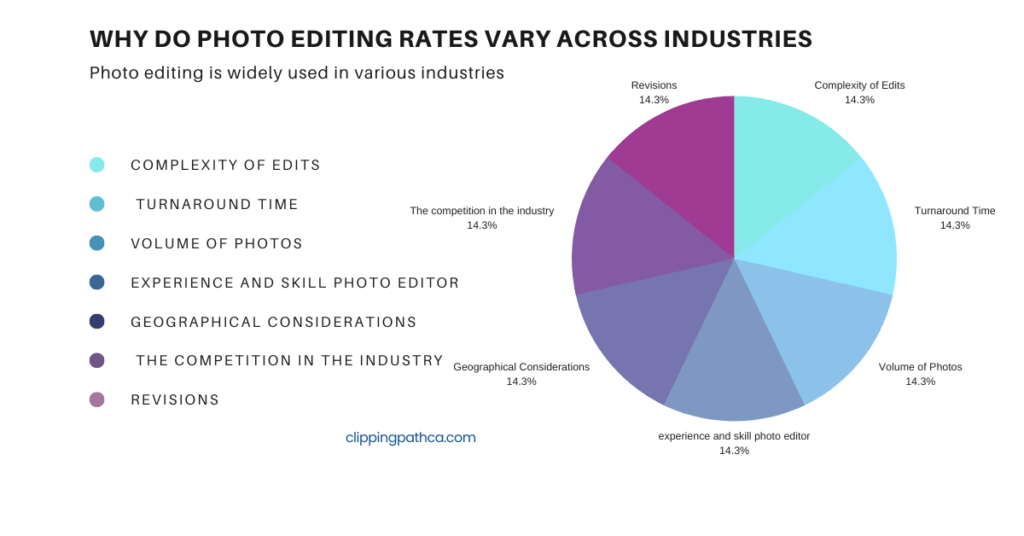
1. Complexity of Edits:
Some industries require more complex photo editing than others. For example, the e-commerce industry often requires extensive retouching of product photos to make them look their best, while the photography industry may only require basic editing such as cropping and color correction.
2. Turnaround Time:
Some industries need photos edited more quickly than others. For example, the news industry may need photos edited within minutes of being taken, while the advertising industry may have more time to work on photos.
3. Volume of Photos:
The number of images requiring editing plays a pivotal role. Higher volumes of images generally translate to lower costs.
4. The experience and skill level of the photo editor:
More experienced and skilled photo editors will charge more than less experienced editors.
5. Geographical Considerations:
The cost of living in a particular region and industry competition level can influence photo editing rates. Competitive markets might lead to lower rates to attract clients.
6. The competition in the industry:
If there is a lot of competition in the industry, photo editors may need to charge lower rates to attract clients. So, in this case, photographers can take advantage.
7. Revisions
It’s important to clarify your policy on revisions with clients. If you offer revisions as part of your service, consider how many revisions are included in your pricing and how additional revisions will be charged. Revisions can add additional time and effort to a project, so it’s essential to factor this into your pricing structure.
The best way to determine the right photo editing rates for your industry is to research the rates charged by other photo editors in your area and take into account the factors listed above.
2024 photo editing rates – How much to charge for photo editing?
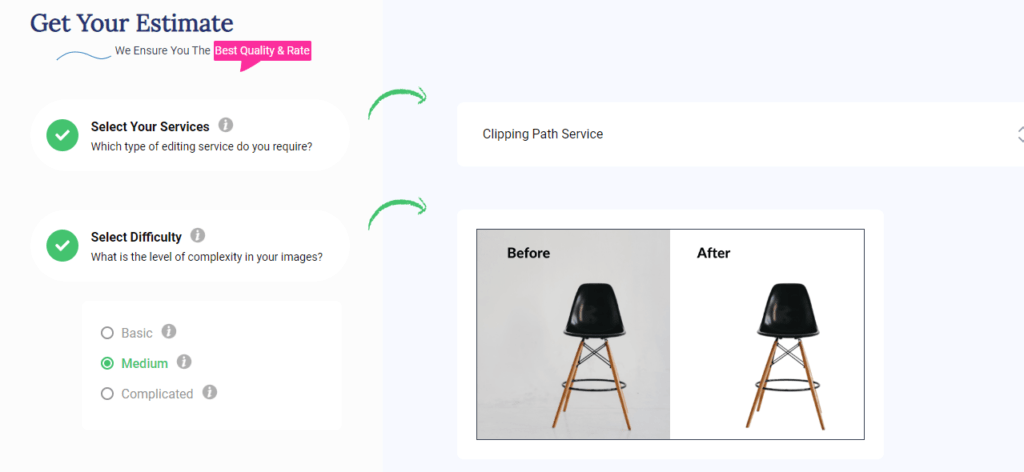
Determining how much to charge for photo editing services can be a challenging task. To help you get started, here are some average rates based on industry standards. To better understand the pricing, you can visit this pricing page and ensure you understand this data clearly.
- Basic photo editing: $0.29-$6.75 per image or $10-$30 per hour or 100-1000 per project
- Advanced photo editing: $20-$50 per image or $50-$100 per hour or 300-3000 per project
- Extensive photo editing: $50-$100 per image or $100-$200 per hour or 500-5000 per project
Here is a pricing table:

Calculating Subtotal Price:
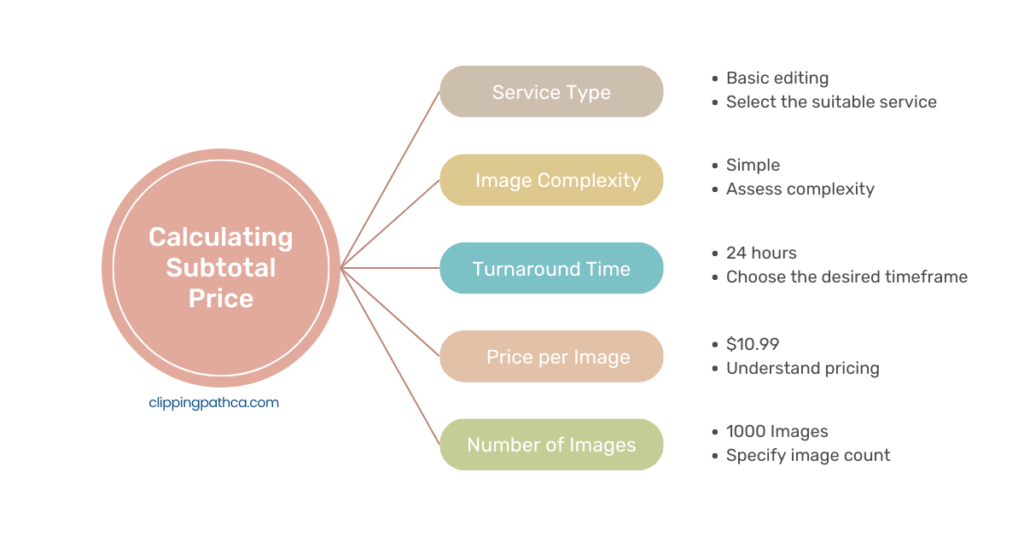
Suppose you have 1000 bottle images requiring basic edits within 24 hours. Let’s walk through the calculation:
- Service Type: Basic editing (Select the suitable service)
- Image Complexity: Simple (Assess complexity)
- Turnaround Time: 24 hours (Choose the desired timeframe)
- Price per Image: $0.29 (Understand pricing)
- Number of Images: 1000 (Specify image count)
The calculation: Subtotal price = 0.29 * 1000 = 290
This straightforward multiplication gives you the subtotal price, which here equals $290.
While these guidelines provide a foundation, remember that specific project requirements can influence the final cost. Factors like complexity and urgency may adjust the price. For precise quotes, don’t hesitate to reach out to your chosen photo editing service provider.
Remember, flexibility is key. As you set your rate, consider the factors you discussed earlier. Rates may also vary based on location, your needs, and the editor’s skill level. So, keep your focus sharp as you move forward.
To explore comprehensive pricing details for various services, head to our ‘Flexible Pricing‘ page. This invaluable resource maps out the intricate journey of pricing adjustments for each service, ensuring clarity and informed decisions.
Pricing Model: Common Pricing Strategies
Choosing between pricing models, whether it’s price per image, price per hour, or price per project, depends on various factors and your business model.
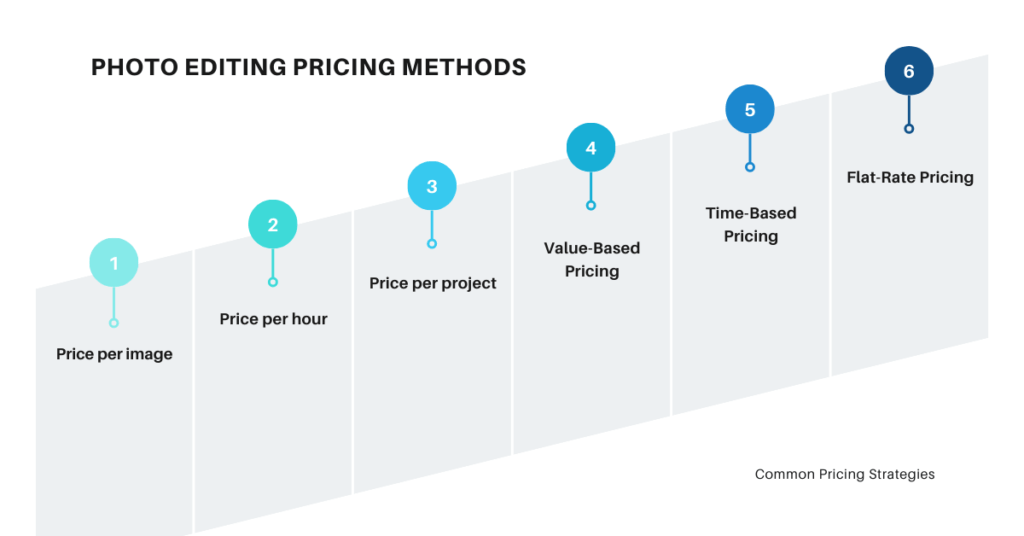
Let’s break down each option to help you make an informed decision:
1. Price per image:
This is a good option for projects with a small number of images or for projects where the edits are relatively simple. It is also a good option for clients who want to have a say in the editing process and who want to be able to request changes.
2. Price per hour:
This is a good option for projects with a large number of images or for projects where the edits are complex. It is also a good option for clients who are not sure how many images they need edited or who want to have the flexibility to add or remove images from the project.
3. Price per project:
This is a good option for projects with a set scope of work and a fixed deadline. It is also a good option for clients who want to have a single point of contact for the project and who want to be able to track the progress of the project.
4. Value-Based Pricing:
Value-based pricing focuses on the value that your editing services bring to the client. Instead of basing your price solely on the time or effort involved, you consider the impact your work will have on the client’s business or personal goals. This pricing strategy requires a deep understanding of your client’s needs and the value they place on your services.
5. Time-Based Pricing:
Time-based pricing is similar to hourly rates but focuses on specific time blocks. For example, you might offer half-day or full-day rates for clients who need an extended period of editing work. This pricing strategy can be advantageous for both you and the client, as it allows for dedicated time to focus on a project without interruptions.
6. Flat-Rate Pricing:
Flat-rate pricing involves setting a fixed price for a specific type of editing service. For example, you might charge a flat fee for basic color correction or retouching services. This pricing strategy works well for standardized editing tasks that can be completed quickly and efficiently.
Remember, regardless of the pricing model you choose, transparency and communication are key. Providing clear explanations and estimated costs will help build trust and ensure a successful working relationship.
Tips for Negotiating Prices
Negotiating prices with a photo editor or photo editing agency can be a valuable skill, so you get the best value for your investment.

Here are some tips to help you navigate the negotiation process:
✅ Do your research. Before you start negotiating, it’s important to know what the going rate is for photo editing services. This will help you to know if the price that you’re quoted is fair. You can do your research by checking online resources, such as industry websites or freelancer marketplaces.
✅ Be clear about your needs. When you’re negotiating, be clear about what you need from the photo editor or company. This includes the number of photos that need to be edited, the level of editing that you require, and the deadline. The more specific you can be, the easier it will be to negotiate a fair price.
✅ Be flexible. It’s important to be flexible when negotiating prices. If you’re not willing to compromise, you’re less likely to be successful. Be willing to negotiate on the price, the deadline, or the scope of work.
✅ Be polite and professional. Even though you’re negotiating, it’s important to be polite and professional. Remember that the photo editor or company is still providing you with a service, and you want to maintain a good relationship with them.
✅ Be prepared to walk away. If you’re not happy with the price that you’re quoted, be prepared to walk away. There are other photo editors and companies out there, and you don’t have to settle for the first one that you contact.
Here are some additional tips that you may find helpful:
- Get quotes from multiple photo editors or companies before making a decision. This will give you a better idea of the range of prices that are available.
- If you’re working with a photo editing company, ask about their cancellation policy. This way, you’ll know what your options are if you need to change your mind or the project is delayed.
- Be clear about your expectations. Let the photo editor or company know what you’re looking for in terms of the quality of the edits, the turnaround time, and the level of communication.
- Be patient. Negotiating prices can take time. Don’t expect to get everything you want right away.
I hope these tips help you to negotiate a fair price for your photo editing services.
Remember, the key to the success of your work is those who can provide high-quality editing services and build strong relationships with you.
Comparing Freelancers vs. Photo Editing Agencies

Photographers need to be aware of the differences between hiring freelancers and working with photo editing agencies because this knowledge can significantly impact their workflow, the quality of their work, and their overall business success. Here’s why understanding the comparison between freelancers and photo editing agencies is important for photographers:

Ultimately, the best way to decide which option is right for you is to consider your specific needs and budget. If you need a quick and affordable option, a freelancer may be a good choice. If you need high-quality work and are willing to pay for it, a studio or agency may be a better option.
Here is a more detailed comparison of the two options:
Freelancers
✅ Pros:
More flexible: Freelancers can work on your project on their own schedule, which can be helpful if you have a tight deadline or need your images edited quickly.
Cost-effective: Freelancers can often be more cost-effective than studios or agencies, as they do not have the same overhead costs.
Personal touch: Freelancers can often give your project a more personal touch, as they will be working directly with you.
❌ Cons:
Lack of experience: Freelancers may not have the same level of experience as a studio or agency, as they may be newer to the industry.
Unreliability: Freelancers may not be as reliable as a studio or agency, as they may have other commitments that could interfere with your project.
Communication challenges: Communication can be more challenging with freelancers, as you may not have the same level of contact with them as you would with a studio or agency.
Photo Editing Agencies
✅ Pros:
Experience: Studios and agencies typically have more experience than freelancers, as they have been in the industry for longer.
Reliability: Studios and agencies are typically more reliable than freelancers, as they have a team of people working on your project.
Communication: Communication is typically easier with studios and agencies, as you will have a dedicated point of contact who will be able to answer your questions and keep you updated on the progress of your project.
Quality: Studios and agencies typically have higher quality standards than freelancers, as they have a reputation to uphold.
❌ Cons:
Cost: Studios and agencies can be more expensive than freelancers, as they have the overhead costs of running a business.
Inflexibility: Studios and agencies may not be as flexible as freelancers, as they may have set hours and deadlines.
Tips for finding a good photo editor or photo editing agency
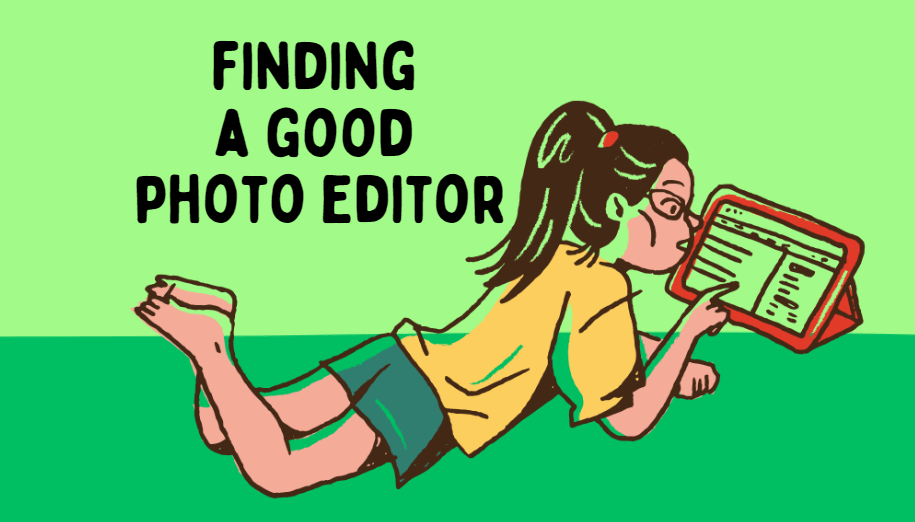
Finding a good photo editor is a critical decision that can impact a photographer’s work quality, efficiency, and overall success. Photographers should know these because choosing the right photo editor is a crucial part of their workflow and the quality of their final images. By understanding the tips for finding a good photo editor, photographers can make well-informed choices and build successful collaborations that contribute to their creative endeavors.
Here are some tips for finding a good photo editor; let’s read them carefully-
✔️ Ask for recommendations from friends, family, or colleagues. This is a great way to get started, as you can trust the recommendations of people you know and trust.
✔️ Look for photo editors with experience in the type of editing you need. If you need specific edits, such as removing blemishes or adding special effects, make sure to find a photo editor who has experience with those types of edits.
✔️ Get quotes from multiple photo editors before making a decision. This will help you compare prices and find the best deal.
✔️ Read reviews of photo editors online. This can give you an idea of the quality of their work and the level of customer service they provide.
✔️ Trial Periods: Many photographers start with a trial period to assess an editor’s skills and compatibility. Knowing how to structure and evaluate these trials is important.
✔️ Check the photo editor’s portfolio. This will give you a good idea of their style and the types of edits they can do.
✔️ Age of the Firm: While not the only factor, a well-established firm might offer more stability, a proven track record, and a wider range of services.
✔️ Area of Expertise: Identifying whether the photo editor has experience in the specific type of editing you require (portrait, landscape, fashion, etc.) ensures that they can meet your creative and technical needs effectively.
✔️ Response Time: A photo editor who communicates promptly can help maintain efficient workflows and ensure that projects progress smoothly.
✔️ Payment considerations. Make sure you are comfortable with the payment terms before you hire the photo editor.
✔️ Schedule a consultation with the photo editor. This will give you a chance to ask questions and get a feel for their personality and work style.
By following these tips, you can find a good photo editor who can meet your needs and deliver high-quality work.
Here are some additional tips:
✔️ Be clear about your budget. This will help the photo editor narrow down their options and give you a more accurate quote.
✔️ Be specific about the edits you need. The more specific you can be, the better the photo editor will be able to estimate the time and cost of the project.
✔️ Be patient. Good photo editing takes time and effort. Don’t expect the photo editor to be able to turn around your project overnight.
By following these tips, you can find a good photo editor who can help you create beautiful and professional photos and succeed in your work.
Are you trying to decide which photo editing agency is a reputable and negotiate prices?
Discover the competitive edge with ‘Clipping Path CA,’ a globally renowned photo editing agency. We’re excited to announce exclusive discounts on bulk orders tailored for photographers and e-commerce businesses like yours.
Don’t miss out on this opportunity to enhance your services while optimizing costs. Elevate your images and boost your business potential with ‘Clipping Path CA.’ Get your fair quote today to explore how we can take your editing prowess to the next level.
Frequently Asked Questions (FAQ)
1. Are the rates mentioned in the pricing table fixed?
The rates provided in the pricing table are indicative and may vary based on specific requirements, complexity, and turnaround time. It’s advisable to request a personalized quote for accurate pricing.
2. Can I negotiate photo editing rates?
Negotiation depends on the editor or company. Some may have room for flexibility, while others have fixed rates. It’s best to communicate openly and inquire about any potential adjustments.
3. What if I need urgent edits? Will it cost more?
Urgent edits often come with a premium price due to the need for quicker turnaround. Discuss your timeline with the photo editor or service provider to determine the associated costs.
4. How do I ensure a fair rate for my photo editing services?
Research prevailing rates in your industry, consider factors like complexity and turnaround time, and aim for competitive but reasonable pricing. Balancing your expertise with market standards is key.
Wrap up
In this article, we have aimed to cover all the significant factors related to determining pricing for photo editing. We’ve outlined key considerations such as complexity, volume, specialization, expertise level, and industry standards, providing a comprehensive guide for establishing fair and competitive rates.
Now, we’d like to hear your thoughts. How do you perceive the insights we’ve shared on pricing for photo editing? Have we successfully addressed all your inquiries or perhaps there’s an aspect we could further explore? Your feedback is invaluable, so please don’t hesitate to share your comments below. Your input will contribute to the ongoing improvement of our content.
Get a free quote on photo editing services today! We’ll help you determine the right price for your project based on your needs and budget.








